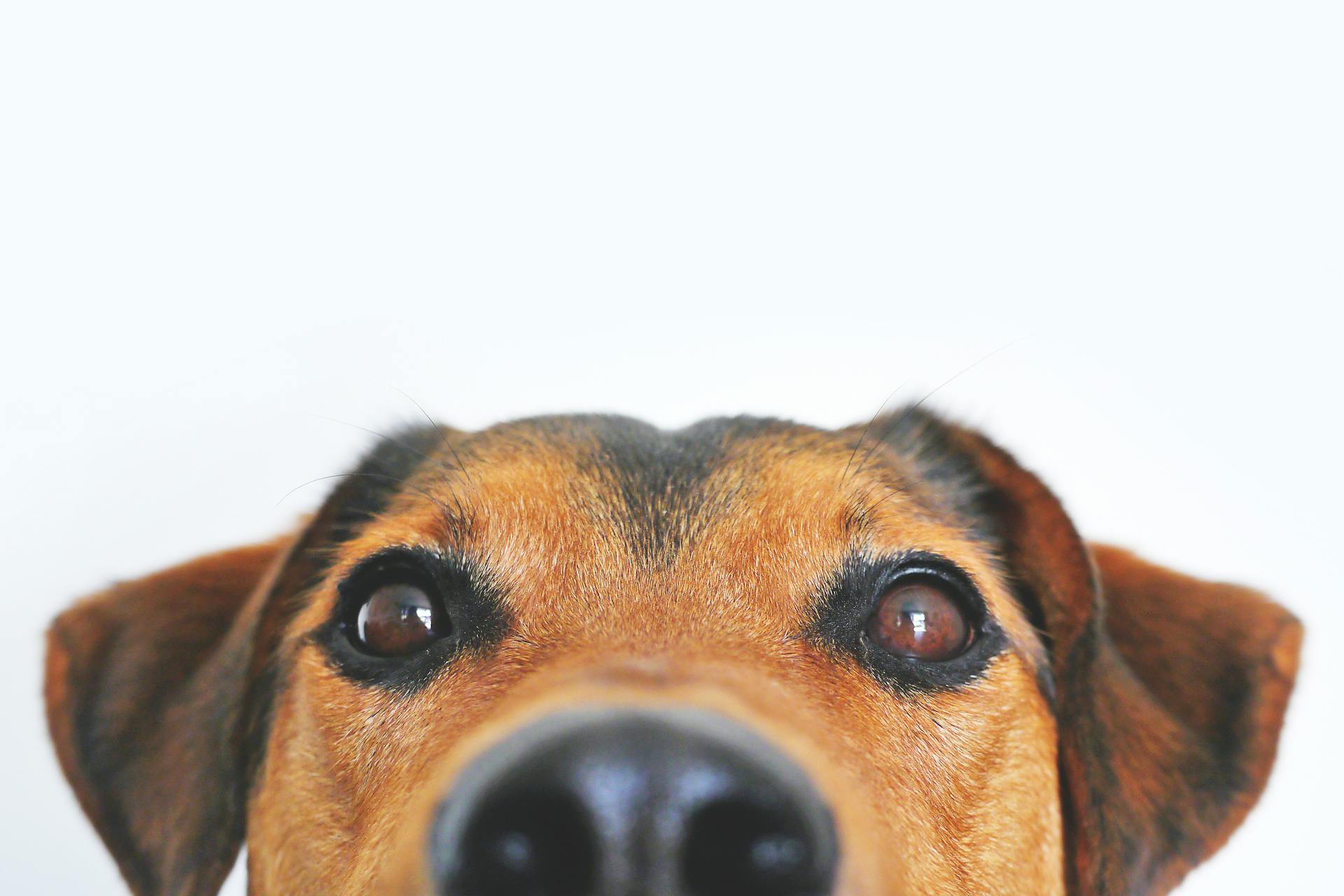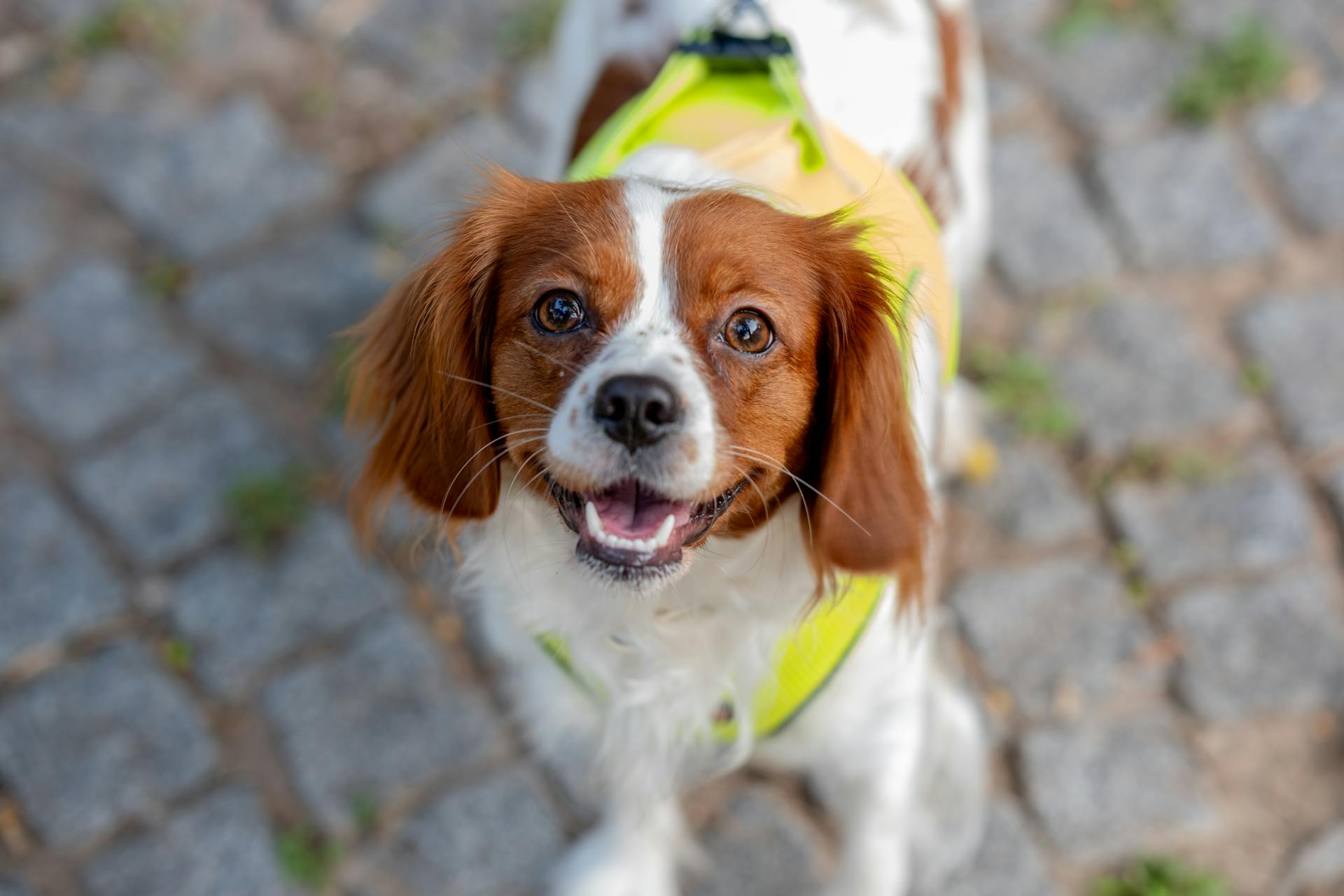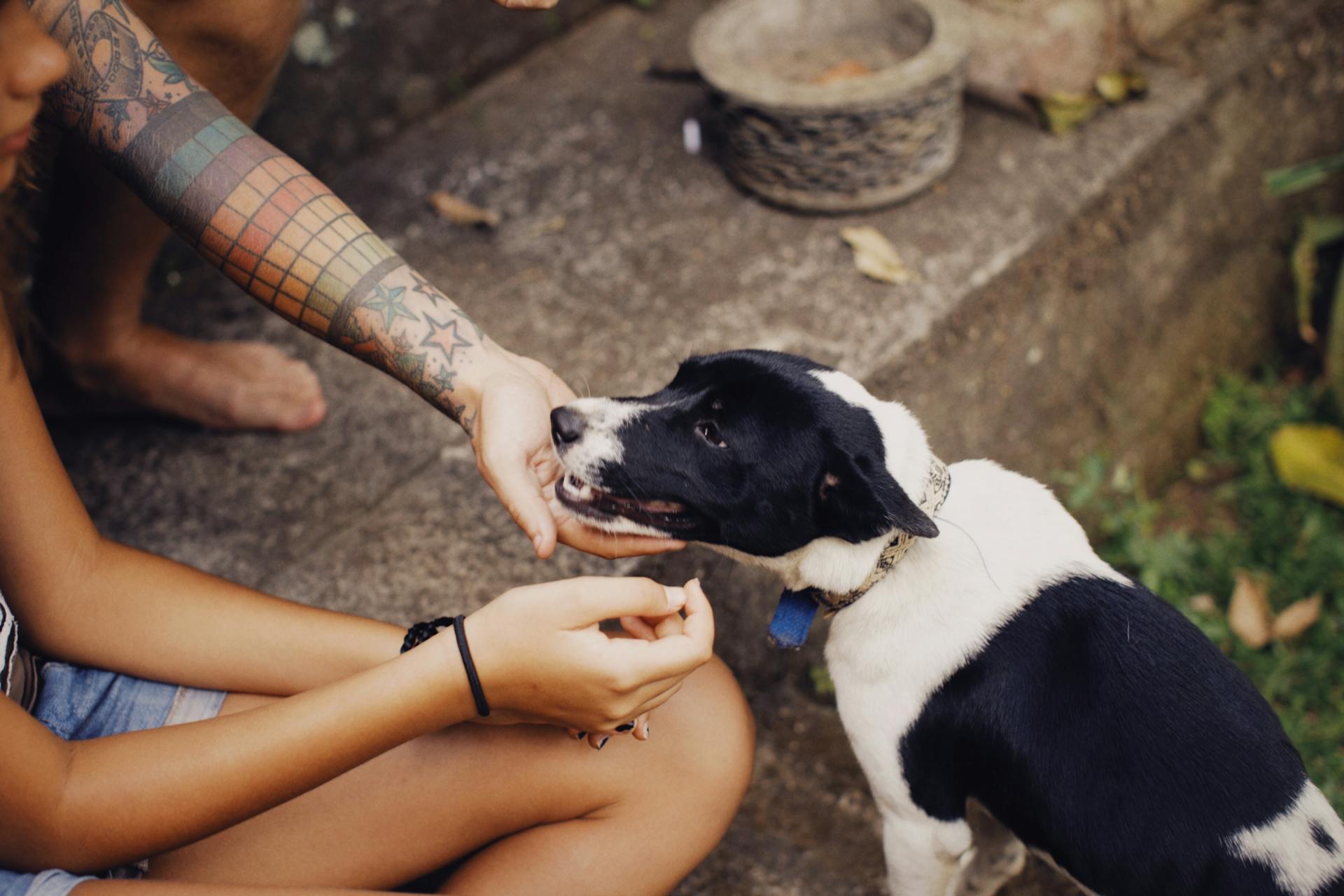
A lump on your dog's buttocks can be a worrying sight, but it's not always a cause for panic.
Skin abscesses are a common cause of lumps on a dog's buttocks, often resulting from a bacterial infection.
These abscesses can be painful for your dog and may require veterinary attention to drain the pus and prevent further infection.
Cysts are another possible cause of lumps on a dog's buttocks, often caused by a blockage in the sebaceous glands.
They can be benign, but in some cases, they may need to be surgically removed to prevent complications.
Some lumps on a dog's buttocks can be a sign of an underlying condition, such as allergies or skin conditions like eczema or dermatitis.
Intriguing read: English Bulldog Wrinkle Infection
Causes of and Types of Lumps
There are many types of lumps and bumps that can appear on your dog's body, and it's essential to know what to look for. Some lumps, like bug bites and abscesses, are relatively easy to identify if you know what your dog has been up to.
Perianal tumors are a type of lump that can develop on a dog's buttocks. They originate from the sebaceous-like structures in the perianal skin and are most commonly found in intact, older male dogs.
Some breeds are at a higher risk of developing perianal tumors, including Beagles, Cocker Spaniels, English Bulldogs, and Samoyed breeds. These breeds may be more prone to genetic factors that influence tumor growth.
If you find a lump on your dog's buttocks, it's crucial to make a note of where it is and take a picture to track any changes. If the lump grows rapidly or changes in any way, you should reach out to your vet for a diagnostic assist.
Here are some common types of lumps found on dogs:
- Perianal tumors
- Bug bites
- Abscesses
- Other bumps that may need a vet's diagnosis
Keep in mind that some lumps may require a vet's examination and testing to determine their cause. Your vet may recommend blood tests, urinalysis, cytology, or imaging to help diagnose the lump.
Recommended read: Vets Dog Treats
Common Lumps and Growths
Some lumps and growths are more common than others, and it's essential to know what to look out for. A perianal adenoma is a benign tumor that can develop around the anus or underside of the tail, especially in intact male dogs.
Lipomas are the most common benign lump in dogs, typically found under the skin of middle-aged or older dogs. They're soft, rounded, and non-painful, and can grow slowly over time.
Skin tags are another common growth that can develop in older dogs, often extending from the skin's surface by a stalk. They're harmless and can appear on various areas of the body, including the chest, legs, face, back, and armpits.
Recommended read: Benign Lump on Dog
Common Lumps
Lipomas are the most common benign lump that dogs develop, a fat-filled tumor found under the skin of middle-aged or older dogs.
These soft, rounded, non-painful masses grow slowly and rarely spread. Any breed can develop lipomas, although overweight or obese dogs are more prone to them.
Sebaceous cysts are another type of common lump, caused by a blocked sebaceous gland, which leads to a buildup of hard, cystic material attached to and under the skin.
Fine needle aspiration is necessary to distinguish sebaceous cysts from other masses, and most of them never cause problems, though occasionally they will burst.
Perianal adenomas develop due to hormonal imbalances in dogs, specifically the presence of testosterone, which stimulates the growth of perianal gland cells, leading to the formation of benign tumors.
Intact male dogs are more prone to developing perianal adenomas, but neutering does not guarantee complete prevention, as hormonal imbalances can still occur in neutered or female dogs.
Here are some common types of lumps found on dogs:
- Lipoma: a fat-filled tumor found under the skin of middle-aged or older dogs
- Sebaceous cyst: a blocked sebaceous gland leading to a buildup of hard, cystic material
- Perianal adenoma: a benign tumor caused by hormonal imbalances, especially in intact male dogs
- Lipoma or fatty growth: a benign tumor of fat cells, often found on the chest or abdomen
- Sebaceous adenoma: a benign tumor of sebaceous glands, often found in Poodles, Maltese, Bichons, and their crosses
Papilloma or Wart
Papilloma or Wart is a common issue in young dogs. They often appear as multiple small lumps on the face and head.
Warts in dogs are caused by a papillomavirus, just like in humans. Dogs that get them often go to dog parks or day care.
A biopsy is necessary to confirm the diagnosis, but the classic feathery appearance of warts is hard to mistake.
Readers also liked: Types of Dog Warts
Skin Tag

Skin tags are a common occurrence in older dogs, and they can appear in various areas of the body, including the chest, legs, face, back, armpits, and more.
They are harmless, fibrous growths that can extend from the skin's surface by a stalk, and dogs may have a single tag or many of them.
Large-breed dogs may be at a greater risk of developing skin tags, but they can appear in any breed.
Cysts and Tumors
Cysts and Tumors can be a concern when it comes to a dog lump on the buttocks. Sebaceous cysts are the most common type of cyst in dogs, and they develop when a sebaceous gland becomes blocked or damaged.
They resemble a pimple and are often found on older dogs. Sebaceous cysts are non-cancerous and usually go away on their own, but it's essential not to squeeze them, as this can lead to infection. If a sebaceous cyst ruptures, it will discharge a white pasty substance.
You might enjoy: What to Feed Dogs When You Run Out of Food
Perianal adenomas, on the other hand, are benign tumors that develop due to hormonal imbalances in dogs. They're more common in intact male dogs, but neutering doesn't guarantee complete prevention. These tumors can be removed surgically, and regular monitoring is crucial to detect any recurrence or signs of malignancy.
Some breeds, such as Beagles, Cocker Spaniels, English Bulldogs, and Samoyed breeds, are at a higher risk of developing perianal tumors. It's essential to stay vigilant and seek veterinary care to ensure your dog's well-being and minimize potential complications.
Here are some key points to remember about cysts and tumors:
- Sebaceous cysts are non-cancerous and usually go away on their own, but don't squeeze them to avoid infection.
- Perianal adenomas are benign tumors that can be removed surgically.
- Regular monitoring is crucial to detect any recurrence or signs of malignancy.
Causes of Adenoma
Perianal adenomas develop due to hormonal imbalances in dogs, specifically the presence of testosterone. Testosterone stimulates the growth of perianal gland cells, leading to the formation of benign tumors.
Intact male dogs are more prone to developing perianal adenomas, but neutering does not guarantee complete prevention. Hormonal imbalances can still occur in neutered or female dogs.
The definitive cause of perianal tumors is still unknown, but testosterone is believed to influence cell proliferation in the glands. This is why intact male dogs have an increased risk compared to females in developing these tumors.
Adrenocortical hormones may play an important role in tumor growth in females. This highlights the complex hormonal dynamics at play in the development of perianal tumors.
Some breeds are at a higher risk of developing perianal tumors, including Beagles, Cocker Spaniels, English Bulldogs, and Samoyed breeds.
Intriguing read: Dog Breeds Watch Dogs
Follicular Cysts
Follicular Cysts are rare skin lumps caused by dilation and rupture of hair follicles. They may look like tumours, but are benign.
Follicular cysts are usually easy for your vet to remove under anaesthetic. This makes them a relatively straightforward issue to deal with.
These cysts are rare, but can be identified by a vet. They are often mistaken for tumours due to their appearance, but are actually harmless.
If you suspect your dog has a follicular cyst, it's best to consult a vet for a proper diagnosis. They can assess the lump and determine the best course of action.
Additional reading: Best Food for Gassy Dogs
Histiocytoma
Histiocytoma is a type of fast-growing, pink button-like lump that's often mistaken for mast cell tumours when it's small.
These lumps are commonly found in dogs under a year of age and tend to stop growing and shrink on their own.
A fine needle aspiration can help diagnose histiocytoma, and the age of the dog is also a crucial factor in making a correct identification.
If the lump starts shrinking within two weeks, no treatment is usually necessary.
You might like: Histiocytoma in Dogs Pictures
Granuloma
Granulomas are fast-growing, raised red lumps that can sometimes have a surface crust.
They look like aggressive tumours but are actually a solid form of bacterial infection.
A biopsy might be required to confirm the diagnosis, but in many cases, we can be sure just from inspection.
Treatment for granulomas typically involves antibiotics, not surgery.
Cancer and Serious Conditions
Skin tumors are the most common tumors in dogs, with many types, including melanoma, squamous cell carcinoma, and mast cell tumors.
These types of skin cancer are more common in older dogs, with mast cell tumors being the most common skin cancer in dogs, especially in breeds like boxers, Boston terriers, and Labrador retrievers.
Mast cell tumors can look like small, freely movable tumors or large, ulcerated, and hairless masses, making it essential to have your veterinarian check them out.
Here are some common types of skin cancer in dogs:
- Melanoma: slow-growing, dark lumps not caused by sunlight
- Squamous cell carcinoma
- Mast cell tumors: fast-growing, pink button-like lumps
Melanomas, in particular, are less malignant than human ones and can be treated with removal, but it's crucial to have your veterinarian evaluate any suspicious lumps immediately.
Mast Cell Tumour
Mast cell tumors (MCTs) are the most common skin cancer in dogs. They can appear as fast-growing, pink button-like lumps that can be well-behaved or very aggressive.
These tumors can be challenging to diagnose, but your vet can usually do it via fine needle aspiration. Sometimes, a biopsy is required to confirm the diagnosis.
MCTs are most often found in dogs older than 8 years of age and in specific breeds, including boxers, Boston terriers, Labrador retrievers, beagles, and schnauzers.
The appearance of MCTs varies tremendously, with some occurring as small, freely movable tumors of the skin, while others may be large, ulcerated, and hairless.
To treat MCTs, they should always be removed with a margin depending on the 'grade' or severity. This is crucial to prevent the tumor from recurring.
Here are some breeds that are more prone to developing MCTs:
- Boxers
- Boston terriers
- Labrador retrievers
- Beagles
- Schnauzers
Soft Tissue Sarcoma
Soft tissue sarcomas are fast-growing, locally invasive tumours of connective tissue, common in large breeds.
These tumours can be mistaken for lipomas if a needle aspirate isn't done.
A biopsy is necessary to tell if a lump is a sarcoma, as they feel just like lipomas.
Sarcomas are often found in unusual places, such as the legs.
Prompt, careful resection with a wide margin is the recommended treatment for sarcomas.
The sooner these lumps are checked, the better the chances of successful treatment.
Recommended read: How to Treat Lick Granuloma at Home
Symptoms and Diagnosis
A lump on your dog's buttocks can be a worrying sight, and it's natural to want to know what's going on. Sometimes, these lumps can be painful for your dog, but other times they may not cause any discomfort at all.
Perianal tumors, which are lumps that grow near the anus, can be a type of lump found on your dog's buttocks. These tumors can grow slowly over months or years, and may eventually rupture and bleed, leading to infections.
Some common symptoms of perianal tumors include round nodules in the skin near the anus, a thickened ring of tissue surrounding the anus, and bleeding nodules. You may also notice your dog excessively licking the anal area or scooting their rear end on the ground.
Here are some possible signs of perianal tumors:
- Round, nodules in the skin near anus
- Thickened ring of tissue surrounding anus
- Bleeding nodules
- Excessive licking of the anal area
- Scooting rear end on ground
A physical exam, urinalysis, and blood work can help your veterinarian determine if the lump is a tumor. If the tumor is malignant, it may require more intensive diagnostic testing and treatments.
Symptoms

Symptoms of perianal tumors in dogs can be quite subtle, but they're essential to recognize early on. A dog with a perianal tumor may not show any signs of pain, but they might pay more attention to the affected area.
Round, nodules in the skin near the anus are a common symptom. These nodules can be a sign that something is amiss.
A thickened ring of tissue surrounding the anus is another possible symptom. This can be a sign of a tumor growing in the area.
Bleeding nodules can also occur, which can lead to infections if left untreated. Infections can cause a range of symptoms, including increased thirst and urination.
Excessive licking of the anal area is a common behavior in dogs with perianal tumors. This can be a sign that your dog is trying to soothe an itch or discomfort.
Scooting the rear end on the ground is another symptom to watch out for. This can be a sign that your dog is trying to alleviate discomfort or itching.

The following list outlines some of the possible symptoms of perianal tumors in dogs:
- Round, nodules in the skin near anus
- Thickened ring of tissue surrounding anus
- Bleeding nodules
- Excessive licking of the anal area
- Scooting rear end on ground
- Colorectal obstruction
- Rectal pain
- Protruding rectal mucous membrane
- Straining to defecate
- Bloody feces
- Vomiting blood
- Increased thirst
- Increased urination
- Decreased appetite
- Lethargy
- Reduced exercise tolerance
- Growth on the testes
- Hypercalcemia, or elevated blood calcium levels
Diagnosis
Diagnosis is a crucial step in determining the cause of your dog's symptoms. A physical exam can help your veterinarian determine if the masses or nodules on your dog's anal area may be tumors.
Your veterinarian may perform a urinalysis and blood work to check for elevated blood calcium levels, a sign of perianal tumors. They may also take a tissue sample by fine-needle aspirate or surgical biopsy to examine under a microscope.
A small percentage of perianal tumors can be malignant, so it's essential to determine the type of tumor your dog has. Chest and abdominal X-rays and ultrasounds can help determine if the tumors have spread to other locations in the body.
Here are some common tests your veterinarian may run to diagnose perianal tumors:
- Blood tests
- Urinalysis (urine test)
- Cytology
- Imaging such as x-rays or ultrasounds
It's essential to follow your veterinarian's guidance on testing and diagnosis, as they can help determine the best course of action for your dog.
Frequently Asked Questions
What does a perianal tumor look like on a dog?
A perianal tumor on a dog typically appears as a small, round, pink nodule around the anus, which can be hairless and slow-growing. If left untreated, it may ulcerate and become infected.
How do you treat a dog's perianal abscess at home?
To treat a dog's perianal abscess at home, apply a warm, wet compress to the affected area for 10-15 minutes, twice daily, to encourage drainage and prevent further complications. This simple remedy can help your dog feel more comfortable and may even resolve the issue on its own.
How do you remove a perianal mass on a dog?
Perianal masses in dogs are typically removed surgically under general anesthesia, preserving surrounding tissue. This minimally invasive procedure aims to remove the tumor while maintaining normal anal function.
What is the life expectancy of a dog with a perianal tumor?
Life expectancy for a dog with a perianal tumor varies from 18 months to 2 years, depending on the treatment approach. Treatment options and their impact on quality of life should be discussed with a veterinarian
Sources
- https://collegehillsvet.com/perianal-adenoma-in-dogs-causes-symptoms-and-treatment/
- https://www.walkervillevet.com.au/blog/help-dog-lump/
- https://www.diamondpet.com/blog/health/sensitive-skin/the-12-lumps-and-bumps-of-canine-skin/
- https://www.dogsnaturallymagazine.com/lipoma-dog-lumps/
- https://wagwalking.com/condition/perianal-gland-tumor
Featured Images: pexels.com


